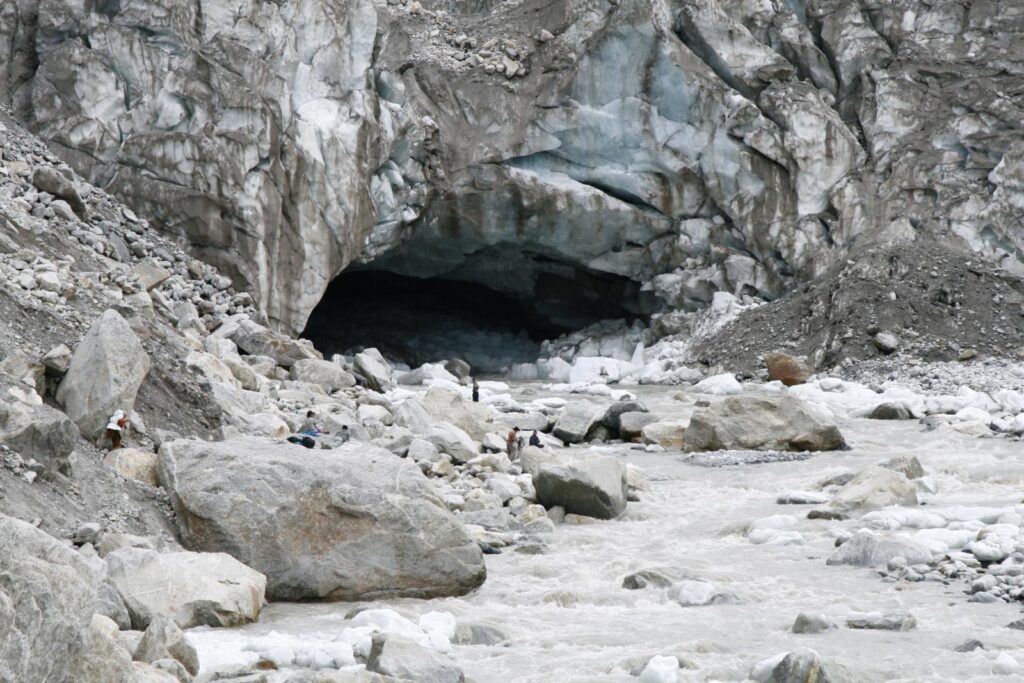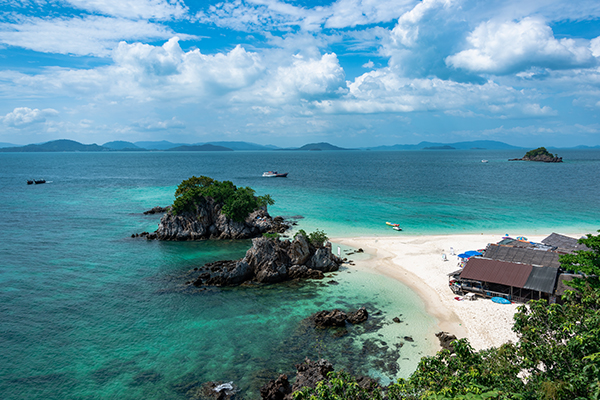Gangotri, the origin of the river Ganga and seat of the goddess Ganga, is one of the four sites in the Char Dham pilgrimage circuit of Uttarakhand. The river is called Bhagirathi at the source and acquires the name Ganga from Devprayag onwards where it meets the Alaknanda. The shrine of Gangotri overlooks the thundering Bhagirathi and is set in the middle of rugged mountains and deodar forests at 9,980 feet above sea level. Gangotri is the spiritual source of India’s holiest river, the Ganga. It is believed that bathing in her waters brings deliverance from sins committed in the present and past births. The actual source of the river is the ice cave of Gaumukh set in the Gangotri glacier. Origin of river Ganges – Gangotri Dham.
The temple at Gangotri was built by Amar Singh Thapa, the Gorkha leader, in the 18th century. Made of white stone, it is situated on the left bank of the Bhagirathi. It is about 20 feet high and stands on a raised platform. The shrine is decorated with a gilded roof and crowned with a central spire. The Maharaja of Jaipur, Madhosingh, renovated the temple in 1935, which possibly explains the Rajasthani style of architecture in its appearance. Near the temple is the Bhagirath Shila, a stone slab where King Bhagirath meditated. Goddess Ganga is the main deity in the temple. Apart from her, Yamuna, Shiva, Saraswati, Annapurna and Mahadurga are worshipped here.
Gangotri | Temple
Gangotri, seat of goddess Ganga, is one of the four sites in the Char Dham pilgrimage circuit. The shrine of Gangotri overlooks the thundering River Bhagirathi and is set in the middle of rugged mountains and deodar forests at 9,980 feet above sea level. Gangotri is the spiritual source of India’s holiest river, the Ganga. It is believed that bathing in her waters brings deliverance from sins committed in the present and past births. The actual source of the river is the ice cave of Gaumukh set in the Gangotri glacier.
The temple at Gangotri, believed to have been sanctified by Adi Shankaracharya, was built by Amar Singh Thapa, the Gorkha captain, in the 18th century. Made of white stone, it is situated on the left bank of the Bhagirathi. It is about 20 feet high and stands on a raised platform. The shrine is decorated with a gilded roof and crowned with a central spire. The Maharaja of Jaipur, Madhosingh, renovated the temple in 1935, which possibly explains the Rajasthani style of architecture in its appearance.
Gaumukh, Gangotri
Gaumukh is where the waters of Ganga trickle down from the Gangotri glacier. This glacier, source of the Ganga, is one of the largest in the Himalayas with an estimated volume of over 27 cubic kilometers. The glacier is about 30 kilometers long and 2 to 4 kilometers wide. Around the glacier are the peaks of the Gangotri Group, including several peaks notable for extremely challenging climbing routes, such as Shivling, Thalay Sagar, Meru, and Bhagirathi III. The glacier flows roughly northwest, originating in a cirque below Chaukhamba, the highest peak of the group.
The trek from Gangotri of about 19 kilometers brings you to Gaumukh (Gaumukh implies cow’s mouth in Hindi – gou, cow + mukh, face). Gaumukh is situated at an astounding height of 3969 meters above sea level. It is a moderate trek which can be extended to include Tapovan or Nadanvan. The trek will give a complete experience, right from self supported journey to camping deep in Himalayas.
Gangnani
Gangnani is 55 kilometers from Gangotri, and is noted for its thermal springs and close-up views of famous mountain peaks. Its peaceful and tranquilizing environment provides an ideal setting for meditation. Almost all devotees stop at Gangnani, enroute, to have bath in the hot water springs at the ashram of Parashar Muni.
Harsil
28 kilometers from Gangotri, Harsil, located in the district of Uttarkashi, is famous for its natural beauty and delicious apples. The picturesque village has the river Bhagirathi flowing through it. Located in the valley, it offers lovely mountain views all around. Harsil is situated at a distance of 72 kilometers from Uttarkashi on the main highway to Gangotri and is at a height of 2,620 meters. From Harsil, the adventurous tourist can trek to Sat Tal, situated just above Dharali, 2 kilometers beyond Harsil, to be greeted by the rewarding sight of seven lakes situated amidst beautiful natural surroundings.
Related Story –
Frequently Asked Questions About Things To Do In Gangotri
Q. How far is Gangotri from Rishikesh?
A. Gangotri is 244 km away from Rishikesh, if you are planning to go by road. But the aerial distance between Gangotri and Rishikesh is 119 km.
Q. Can I go for trekking in Gaumukh?
A. Gaumukh– Tapovan Trek is one of the most enjoyable treks in India as the views from this place will leave you awestruck and transport you to a delighted world of the glaciers, ice, and majestic views.
Q. Is Nelong valley open in winter?
A. The best time to visit Nelong Valley is from May to November and it remains closed during wintertime.
Q. Which is the easiest way to reach ?
A. The easiest way to reach Gangotri is through the train. The closest railway station to Gangotri is located in Rishikesh. Both places are located at a distance of 250 kilometres. You can either board a bus to Gangotri or hire a taxi from Rishikesh to your destination.
Q. Why Glacier is melting so fast?
A. As the temperature is going to rise, these glaciers melt fast due to their small sizes and the water produced from them flows down and seeps into the crevasses of the Gangotri glacier, causing it to melt from the bottom.
















